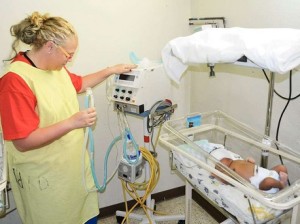
22
May
Two infant ventilators valued at over J$2,000,000.00 were officially donated to the Paediatric ward of the St. Ann’s Bay Regional Hospital on November 12, 2012 by the Issa Trust Foundation. The Foundation’s donation is a significant upgrade to the manual technique being used by the facility, called bag mask ventilation. Ventilators are machines used to provide breathing support for ill or premature babies, as often they are too weak to breathe properly on their own. Twelve boxes of pharmaceuticals and medical supplies were also presented to the facility.
Dr. Coralie Antoine, Paediatric Consultant at the facility thanked the Issa Trust Foundation saying, “We frequently manage extremely premature infants and very ill infants with various respiratory conditions who require ventilatory support. In the past, we have had to rely on the availability of ventilators at Type A hospitals necessitating the transport of unstable infants under less than ideal conditions. With these ventilators, we will be able to better manage our newborns on site. This donation will go a long way in improving our perinatal and infant morbidity and mortality rates and will reduce the need for transport of these ill infants to other facilities…”
Eleven nurses and five doctors from the facility also benefitted from ‘hands on’ training in the use of the special equipment. Training encompassed a myriad of topics which include; the care of intubated neonatal patients, revision of the components of the baby log ventilator and bag mask ventilation, among other key topics. Training facilitators Cheryl Dominick, RRT-NPS and Christine Franciscovich, MSN, CRNP, NNP- BC, who are volunteers from the Children’s Hospital of Philadelphia, have been coming to the island for over five years to assist in the foundation’s mission.
The critical nature of the machines and their necessity was brought immediately into focus as during the training two babies stopped breathing and were intubated by the volunteers, and the nurses and doctors who had just received training. One of the volunteers, Cheryl Dominick said, “We stood watching the baby’s chest not rising, saturations dropping …It became evident in that moment that more ventilators and immediate training were needed to save the lives of these babies in Jamaica.”
Another team of volunteers is expected to return in January 2013 to continue the training as it was interrupted by the passing of Hurricane Sandy. Additionally, they will bring a biomedical technician to service the donated machines.
Mrs. Diane Pollard, Chief Executive Officer of Issa Trust Foundation, said “Through our partnerships, our goal is to provide more kids and their families with what they need the most, their health; so that we can satisfy their boundless hopes and dreams of a healthy future.”
The Issa Trust Foundation was established by the Couples Resorts and has been involved in the enhancement of paediatric health care in north-east Jamaica since January 2005. Their partnership with the North-East Regional Health Authority continues to yield positive results for patients, especially the paediatric clientele. The Foundation is also supported by the Fraternal Order of Eagles another donor organization in the USA, established in 1898.
The Issa Trust Foundation has demonstrated a keen interest in the parish of St. Mary, targeting the hospitals, clinics and underserved areas in the parish. In July 2012 the Foundation donated a twenty foot container valued at US$ 150,000 to the St. Mary Health Services. They have also initiated strategic outreaches in Portland and St. Ann. Since 2012 they have also demonstrated much interest in developing the St. Ann’s Bay Regional Hospital.
Contact:
Shauna Llewellyn – Gordon
Regional Public Relations and Advocacy Officer (Acting)
North East Regional Health Authority (NERHA)
Units 34-38 Ocean Village Shopping Centre
Ocho Rios, Jamaica W. I.
Tel: 795-0102, 795-3107
Mobile: 318-0104, 457-0638
Email: shauna.gordon@nerha.gov.jm
and
Diane Pollard
President & CEO
Issa Trust Foundation
Email: issatrustfoundation@yahoo.com









Connect With Us